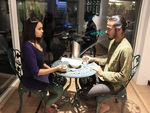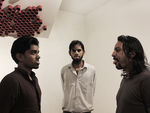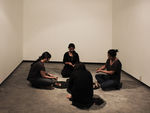INTERLOCUTION
GIFT OF TONGUE -
PERFORMANCE event
The title Gift of Tongues carried multiple meanings. It referred to the Christian Pentecostal concept of an utterance, partly or wholly unintelligible, produced under the influence of ecstatic religious emotion and conceived to be a manifestation of the Holy Ghost’ (Oxford English Dictionary).The performance was however in dialogue with the myth of Philomela. In the Latin poet Ovid’s account of this story a young woman Philomela is raped by Tereus. She then had her tongue cut out by the rapist to impose silence upon her. The performance consequently mixed sounds with highly charged silences, and gave the male tongue a bitterly ironic significance.



The Gift of Tongue performance was achieved by the help of eight volunteers who generously provided me with their participation. Each volunteer were divided into three distinct groups who all acted simultaneously in different parts of the gallery (seven Art, New Delhi) 2013. The work interrogated patriarchy and the foregrounding of masculinity. It asked questions of repressed sexuality of male, insecurity and guilt in the context of sexual desire of women. The work thus confronted Indian power relations in relation to gender and religion.

Gift of Tongue, performance stills, Seven Art Gallery,
New Delhi, India.2013
Follow this link to see other works from the show- GIFT OF TONGUE
Script:
One group consisted of seated women continually sharpening pencils. Their action appeared to be formal and ritualistic but was simultaneously casual and mundane. The sharpened pencil emerged as a paradoxically phallic object which comically got shorter and shorter the longer the women worked on it. This performance asked questions about women’s pleasure and the nature of their desire and about male sexual insecurities in the face of female sexuality.
In the second group three men stood in bowls of water facing each other with their tongues hanging out. Again the action was ambiguous, paradoxical and used humor to instruct. Were these men regressing and behaving like cheeky children, forced to stand in the corner as a punishment, and outraging their parents, not to mention the art world audience? Certainly not. The gesture here was neither sexual, nor childish mockery, but operated in a medical context.
The males stood dis-empowered, and waiting to be examined, while at the same time trying In the third group a man and a woman set across each other around a coffee table were engaged in a cycle of feeding. The woman gave Khir (an Indian sweet dish made out of rice and milk) to the man, a gesture which symbolized lustful consumption. The man poured a glass of water upon the women’s head, which was conversely an act of purification. Ye the act posed the question: whose purification? Is the man trying to cleanse the woman or to release himself from his own guilt?







